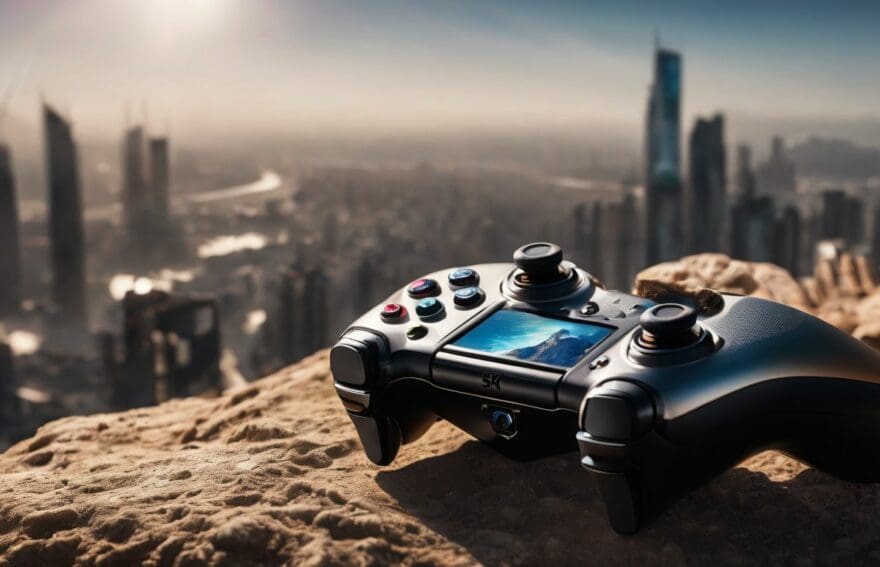The Language of Motion: Understanding FGC Notations

Updated On: November 13, 2025 by James Connolly
Ever found yourself grappling with a fighting game tutorial, feeling as though you’re trying to crack an enigmatic code? You’re certainly not alone in that tussle. We’ve all encountered the perplexing labyrinth of FGC notations, which might as well be a clandestine language.
But fear not—our guide is here to demystify those confounding sequences of numbers and letters, transforming them into crystal-clear directives you can actually put into action. So let’s dive in together and decode the language of the gaming elite!
Understanding Fighting Game Notation
Notation in fighting games is the language used to describe specific joystick and button inputs. It is essential for players to understand these notations in order to execute complex moves and combos effectively during gameplay.
Understanding notation allows players to communicate and understand moves, strategies, and techniques within the fighting game community.
What is notation?
Notation in the world of fighting games is a shorthand language that players use to quickly share and understand complex commands, movements, and strategies. It’s like a secret code for gamers where every number or letter represents a specific action on the joystick or buttons.
We rely on this system to break down intricate combos into easy-to-digest pieces.
In our community, we’ve developed an input system that uses numpad notation for precision and clarity. Picture the layout of your computer’s numpad – each direction corresponds to a number from 1 through 9.
This makes it much easier for us to communicate technical moves without getting lost in translation, no matter what language we speak. Now that you grasp what notation means let’s dive into why this is crucial for mastering fighting games.
Importance of notation in fighting games
Understanding FGC notations, such as numpad notation, is essential for players to improve their skills, communicate effectively, and develop a deeper understanding of fighting games.
This language agnostic notation system provides a standardised method for players to communicate and understand the motions and inputs for different characters in fighting games. It enables quick understanding and discussion of complex inputs, allowing players to effectively communicate strategies, combos, and move sets with one another.
Numpad notation serves as a crucial tool within the gaming community, facilitating seamless communication and contributing significantly to enhanced gameplay experiences.
Common Examples of Notation
Numpad notation and TEKKEN/8-way notation are just a few examples of the different types of notations used in fighting games. Each notation system has its own unique way of representing joystick inputs, making it important to understand the differences between them.
Numpad notation
Numpad notation simplifies complex joystick inputs by using numbers to represent each direction, making it easier to understand and communicate with other players. It allows for precise descriptions of motions and combos without language barriers or confusion.
Street Fighter enthusiasts have adopted this system widely, as it provides a standardised method for discussing character moves and strategies effectively within the fighting game community.
Understanding numpad notation is crucial for enhancing gaming skills, fostering clear communication, and gaining a deeper comprehension of fighting game mechanics.
TEKKEN/8-way notation
Continuing from our discussion of numpad notation, TEKKEN/8-way notation provides a simplified method for notating directional inputs in games like Tekken. Instead of using numbers resembling a numpad, TEKKEN/8-way notation simplifies inputs into directions such as up, down, left, and right.
This system makes it easier to communicate specific moves and combos within the fighting game community.
TEKKEN/8-way notation is essential for players to effectively discuss movement and attacks within Tekken and other similar fighting games. It enables gamers to quickly comprehend complex movements and share strategies without ambiguity or confusion.
Standard notation
In standard notation, specific buttons are represented by letters. For example, “LP” may represent a light punch, while “HP” denotes a heavy punch. This allows players to quickly understand and communicate the type of attack or input being used in the game.
Standard notation provides a clear and consistent way for players to discuss and understand the moves they are using or facing in fighting games.
Players can use standard notation to learn and master combo inputs more effectively. By understanding the meaning of each letter abbreviation, such as LP for light punch or HP for heavy punch, gamers can efficiently comprehend complex combinations with different attacks and timings.
How to Read and Use Notation
To read and use notation, players need to understand directional inputs, attack buttons, special moves, and combos. This language of motion allows for precise execution of moves in fighting games.
Directional inputs
Understanding directional inputs is crucial for mastering fighting game notation. Numpad notation, often used in the fighting game community, employs numbers to represent joystick inputs, making it easier to communicate and understand complex motions.
This standardised method allows players to effectively convey character-specific moves and execute advanced combos in a language-agnostic manner. As passionate gamers, recognising and interpreting directional inputs enables us to enhance our skills, strategise more effectively, and deepen our understanding of frame data and combo moves within the gaming environment.
Attack buttons
When engaging in fighting games, understanding attack buttons is vital for executing effective moves. These buttons are essential components of a player’s arsenal, allowing them to unleash various offensive maneuvers and combos in the game.
By mastering the intricacies of attack buttons, players can effectively control their characters and execute powerful strikes that can turn the tide of battle.
Players must familiarise themselves with different types of attacks such as light punch (LP), heavy punch (HP), light kick (LK), and heavy kick (HK). Each attack button corresponds to a specific type of strike or move, providing players with versatile options during combat.
Special moves
Special moves in fighting games refer to unique and powerful attacks that are executed by specific input commands. These moves often require a combination of directional inputs and attack buttons to perform, adding complexity and depth to gameplay.
Understanding the notation for special moves is crucial for players to execute these powerful attacks effectively during combat. Numpad notation provides a standardised method for communicating these inputs, allowing players to discuss and strategise around special moves with precision and clarity.
Mastering the language of motion notations enables gamers to unleash devastating combos and dominate their opponents in the competitive world of fighting games.
Notation systems like numpad notation play a pivotal role in helping gamers understand, communicate, and execute special moves seamlessly across various titles within the fighting game genre.
Combos
After mastering special moves, understanding combos becomes crucial in fighting games. Combos are sequences of attacks that, when performed correctly, can deal significant damage and even lead to victory. Here’s how to read and use notation for combos:
- Directional inputs play a key role in executing combos, as specific sequences of movements are required to perform each attack in the combo.
- Attack buttons are crucial in combos – different combinations of attack buttons correspond to different attacks within a combo.
- Special moves are often incorporated into combos to create devastating effects – understanding how to seamlessly integrate them is essential.
- Combos involve chaining together a series of attacks and movements with precise timing to maximise damage and pressure on opponents.
- Prefixes like LP (Light Punch) and HP (Heavy Punch) indicate the strength or properties of an attack within a combo, affecting its speed and power.
- Efficiently executing combos requires quick reflexes, strategic planning, and mastery of notation for smooth gameplay flow.
- Using accurate notation for combos allows players to communicate complex strategies effectively and understand the intricacies of each character’s move sets.
- Mastering notation for combos is fundamental for competitive gaming success – it empowers players to unleash devastating sequences that can secure victories.
Prefixes in Notation
Understanding the meaning of prefixes like LP, HP, and other alphanumeric combinations is essential for executing specific attacks and combos in fighting games. Mastering these prefixes can give players a significant advantage in their gameplay.
Understanding the meaning of prefixes like LP, HP
In fighting game notation, the prefixes LP and HP stand for “light punch” and “heavy punch,” respectively. These prefixes are used to indicate different levels of intensity or strength when it comes to attacking moves in the game.
For instance, LP signifies a quick and less damaging punch, while HP represents a more powerful and impactful punch. Understanding these prefixes is crucial as they help players differentiate between various attacks and strategise their gameplay accordingly.
Learning the meaning of prefixes like LP and HP enhances our ability to execute specific attacks with precision during gameplay. It allows us to make informed decisions about which moves to use in different situations, thereby contributing to our overall performance in fighting games.
Fan Feed: Use of Notation in Fighting Game Community
Passionate gamers across the FGC community utilise notation as a shared language for discussing strategies and combos. Notation, such as numpad notation, is widely embraced and endorsed to effectively communicate complex inputs within the gaming community.
This system serves as a standardised method to articulate move sets and character-specific mechanics in fighting games, aiding players in enhancing their skills and understanding game intricacies.
By adopting this common language of motion, passionate gamers can devise new tactics, share knowledge, and foster deeper connections within the vibrant FGC community.
Conclusion
In conclusion, understanding FGC notations, such as numpad notation and TEKKEN/8-way notation, is vital for gamers looking to enhance their skills and strategic communication in fighting games.
Learning the language of motion through these notations allows players to effectively share combos, strategies, and move sets within the gaming community. It offers a standardised method for discussing character inputs across different games and ensures clear comprehension of complex commands and combos.
Embracing FGC notations promotes a deeper understanding of game mechanics and fosters a sense of inclusivity in the diverse world of fighting games.
FAQs
1. What is FGC notation in fighting games?
FGC notation, part of the fighting game terminology, is the specific language used to describe control inputs and combo notations in fighting games.
2. How does combo notation help players?
Combo notation helps players understand and execute a series of moves, known as a combo, by using precise input notations that form a part of the motion language in gaming strategies.
3. Why do we need to learn motion language for Street Fighter?
Learning the motion language for Street Fighter allows you to accurately perform fighting game commands which are essential to master the game’s mechanics and enhance your gameplay.
4. Can understanding input notation improve my gameplay?
Yes! Understanding input notation will guide you through executing complex combos and strategise better with clear knowledge from a fighting game glossary.
5. Are there different types of control inputs across various fighting games?
Whilst many controls are universal, some fighting games have unique commands; therefore it’s important to study their specific control inputs for effective execution during gameplay.


